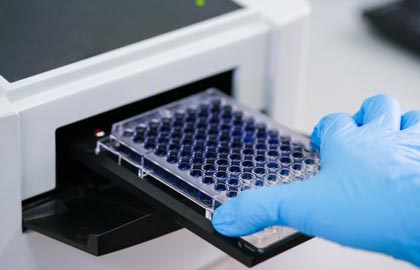How Lab Automation is Supporting COVID-19 Testing and Research
As drug discovery and research efforts for COVID-19 therapies have inherited the spotlight in pharma and clinical labs around the world, interest in automated liquid handlers and robotics that can handle the workload has been increasing rapidly. This should not be surprising, as large-scale testing is needed to process thousands of patient samples every day and the money has been pouring in for coronavirus research. To that end, high throughput capabilities are needed to accommodate routine applications in PCR testing, ELISA, nucleic acid purification, next generation sequencing, and cell culture analysis. Such automated technologies also benefit labs by promoting physical distancing between staff, a necessary practice to uphold during this era, but one that can reduce lab productivity in the absence of automation.
The most fundamental technique to combat the COVID-19 pandemic is real-time (RT) PCR, the primary tool used to test people for the virus and therefore the biggest driver of lab automation during this time. RT-PCR testing is used to detect the presence of SARS-CoV-2 antigens, a process which demands a great deal of hands-on work. The process begins with the extraction of RNA from patient samples, which is combined with nucleotides and a special enzyme that copies the RNA into DNA. This new DNA is then amplified until there is enough sample to work with. Amplification primers, which are short sequences of DNA unique to the coronavirus, are then added to the sample with an enzyme and other chemicals in order to unzip the DNA strands. The amplification primers attempt to match up with the DNA sequences. If the primers are unable to combine with the DNA in the sample, then the DNA can’t be replicated, and the test will register as negative. If the DNA does replicate, however, the test will register as positive.
While RT-PCR tests are being used globally to diagnose cases of COVID-19, these tests only detect if the virus is present, not if a person has developed antibodies. For antibody detection, an enzyme-linked immunosorbent assay (ELISA) may be used. For this test, a sample of human serum, whole blood, or plasma, is incubated with a viral SARS-CoV-2 protein. If the patient has antibodies to the viral protein, they bind together. The bound antibody-protein complex can subsequently be detected with an additional wash of antibodies that produce a color or fluorescent-based readout. Demand for such antibody testing is booming right now, which in turn is boosting the sales of automation technologies that support high throughput ELISA.
Automation systems for next generation sequencing are also on the rise. This technique is able to sequence huge swaths of DNA, and therefore the technology can reveal more information than RT-PCR. Next generation sequencing works by fragmenting DNA and generating short sequence reads, which are then reassembled using bioinformatics to piece together a complete sequence of a target gene or genome. In terms of COVID-19 testing, the technology is used to investigate whether a patient is infected with other viruses, acquire the genetic makeup of the virus, and study its genetic mutations. Thus, next generation sequencing is perhaps the most valuable research tool available to study how the coronavirus is evolving over time.
In support of the three most common aforementioned analytical techniques for COVID-19 testing activities, there are a plethora of automated liquid handlers and robotic systems already on the market that are seeing an uptick in demand thanks to the wave of increased funding for studying SARS-CoV-2. In fact, many suppliers are beginning to customize these systems specifically for work related to the coronavirus. One example is Hamilton Company, the leading supplier of laboratory robotics, which recently released two new automated assay workstations based on the company’s Microlab STARlet liquid handling station. The MagEx STARlet assay workstation provides high-throughput magnetic bead-based RNA extraction of biological samples, and the PCR Prep STARlet assay is pre-configured and qualified to automate high throughput pre-PCR sample setup using the latest protocols from the CDC. Both of these workstations are designed to work with the assay requirements of any provider. Tecan, also a leading supplier of laboratory automation, is touting its Freedom EVO platforms and DreamPrep NGS solution as ideal sample prep stations for coronavirus research and detection. Meanwhile, Eppendorf offers the epMotion series for automated liquid handling in COVID-19 testing and research, which is available in four different formats.
The sheer magnitude of the pandemic means that laboratory automation technologies are being embraced more than ever for their ability to drastically reduce the bottlenecks in sample prep and process samples at a much faster rate than humans. Although COVID-19 testing and research efforts are currently the main driver, the need for lab automation has been accelerated in other laboratories too as a means of helping them operate more safely and efficiently. The current market outlook for lab automation is just one of the many areas of analytical tools and technologies covered in the SDi Global Assessment Report 2020, which was most recently updated in June in order to address how market conditions have evolved during the pandemic.




